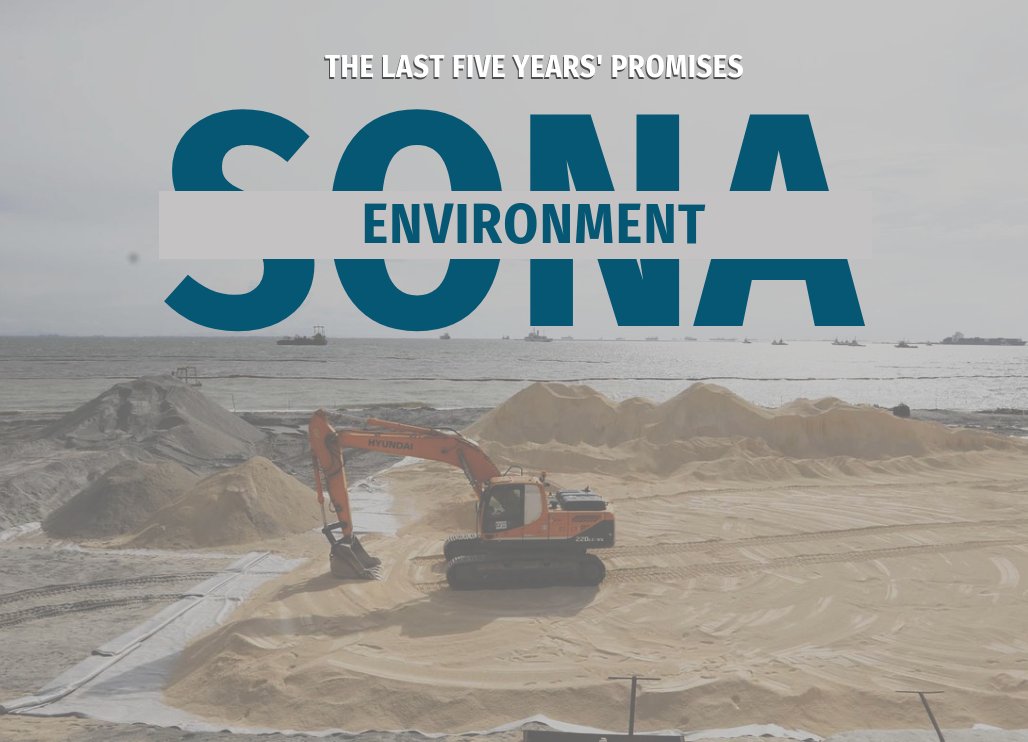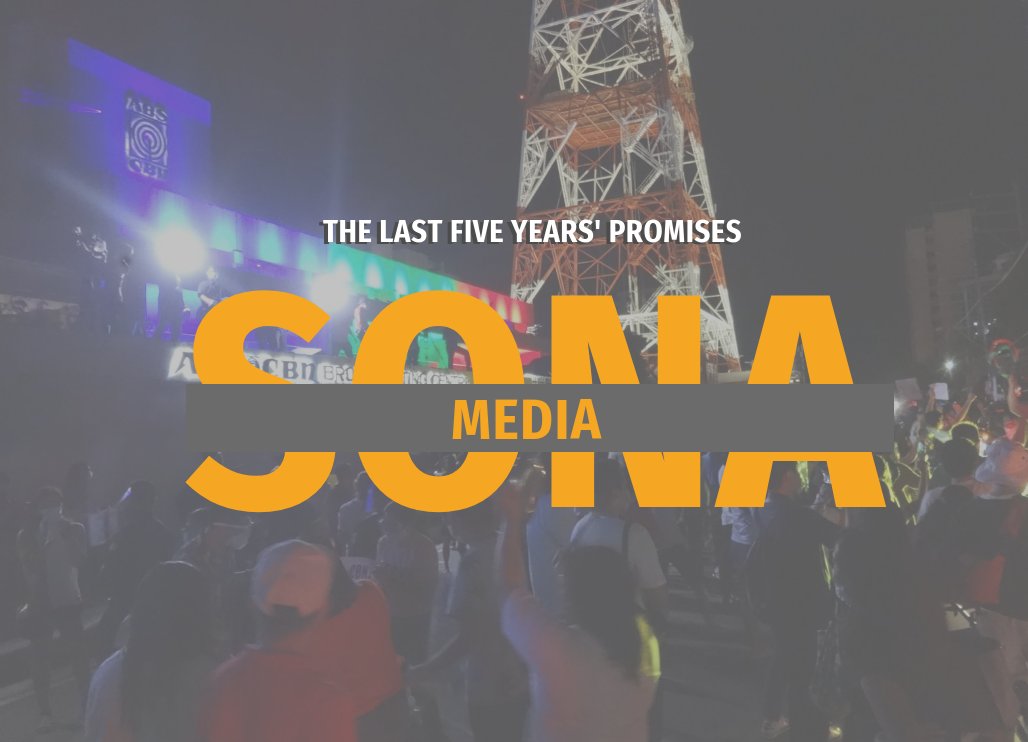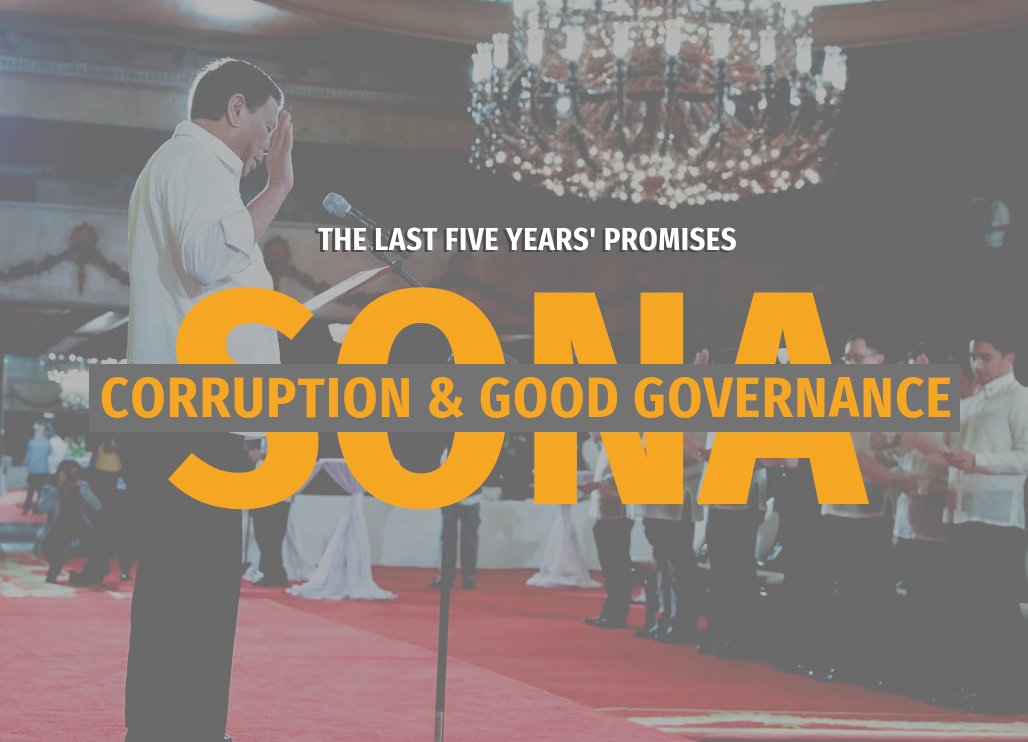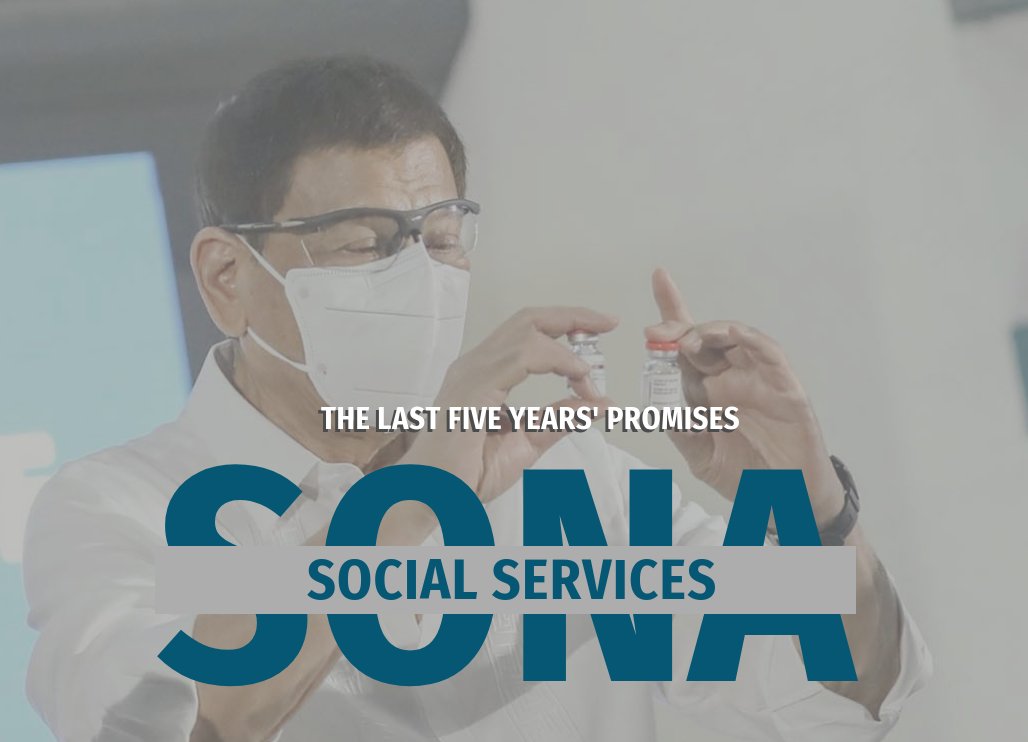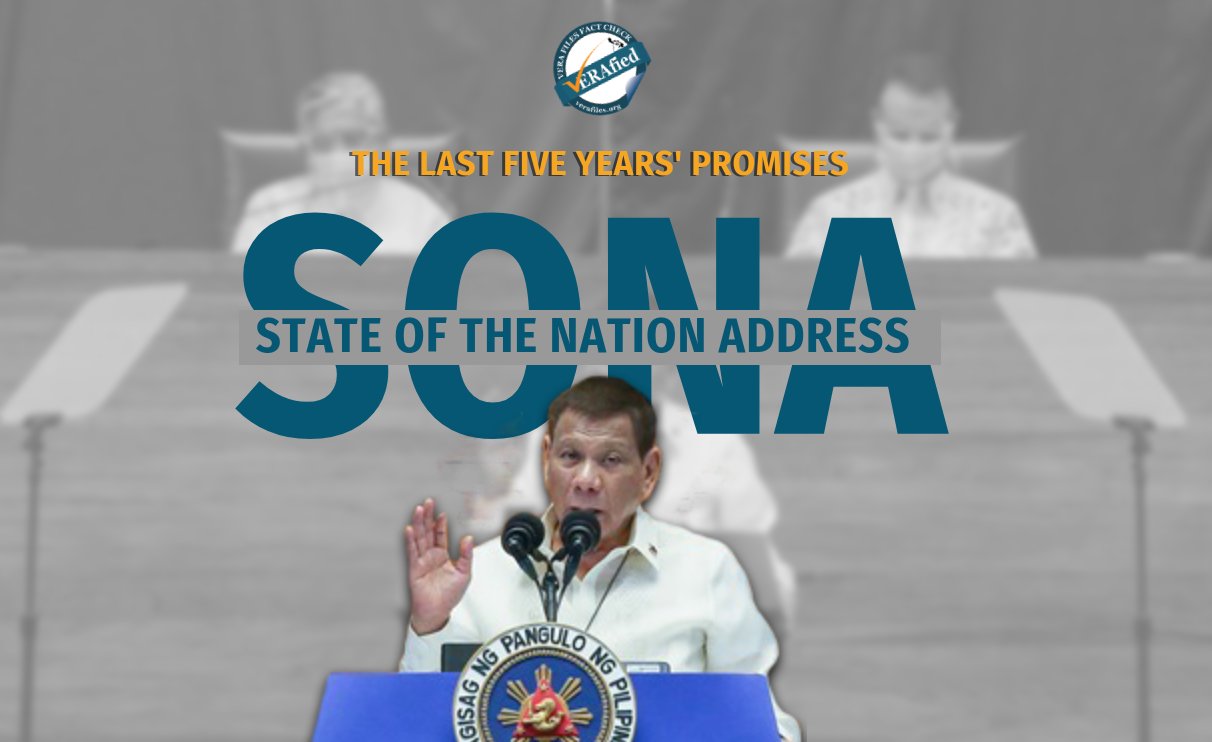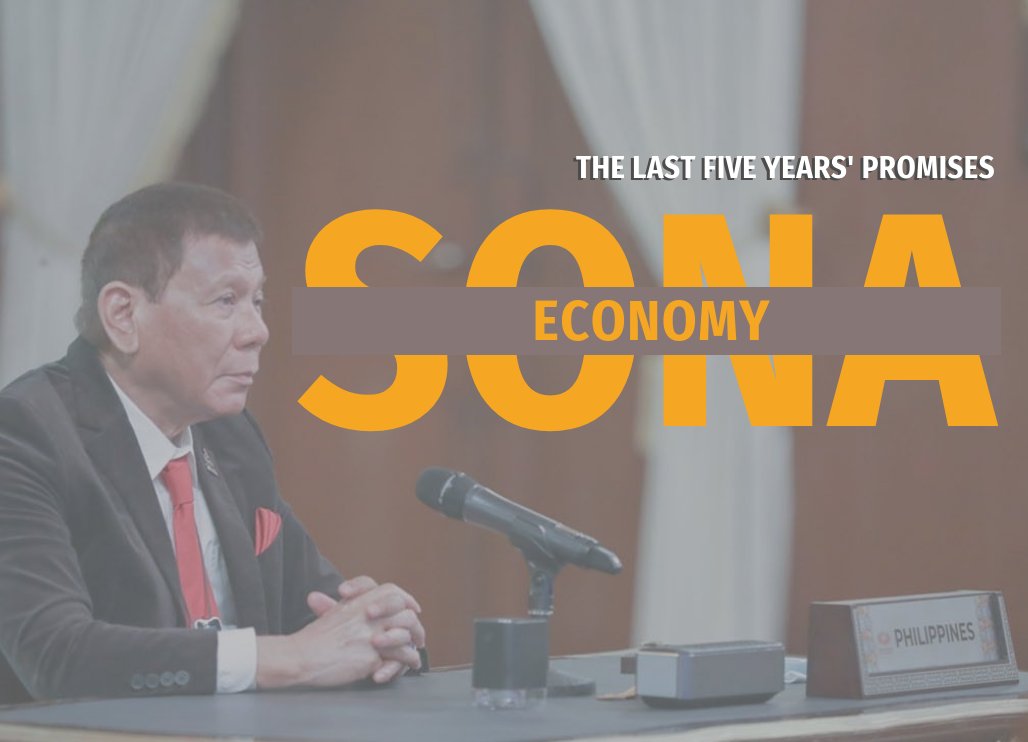President Rodrigo Duterte expressed hope “to see concerted efforts in protecting the environment” in his penultimate State of the Nation Address in 2020. A year later, his hope remains a dream as bills on disaster mitigation, administration of Boracay’s rehabilitation, and resource management are stalled in Congress.
Persistent strides were taken in rehabilitating the country’s ecotourism sites, especially in Puerto Galera and Southern Cebu, through capacity assessments conducted amid the coronavirus disease 2019 (COVID-19) pandemic.
But Duterte ultimately countered his promise to limit the extraction and exportation of the country’s mineral resources when he signed Executive Order 130 on April 14, 2021 lifting the moratorium on mining agreements imposed by former president Benigno Aquino in 2012.
The order allows the government to once again enter into new mineral agreements, subject to the Philippine Mining Act of 1995 and other relevant laws. Duterte said this would assure the supply of raw materials for the government’s Build, Build, Build projects and generate employment in rural areas.
The president expressed the need for the country to better prepare for calamities but resolutions for the enactment of a disaster resilience authority have been languishing in Congress since 2018.
Here’s how the president fared on his promises on environment protection and rehabilitation:
PROMISE: Create department of disaster resilience |
|
I emphasize the creation of the Department of Disaster Resilience. Our people‘s safety cannot be delegated to a council or commission. (SONA 2020) “[W]e need to hasten the establishment of a Department of Disaster Resilience (DDR) so that these [sic] department focus on the natural hazards and climate change. I urge Congress to fast-track the passage of the Administration of this bill—Administration version rather.” (SONA 2019) “[W]e, in the Cabinet, have approved for immediate endorsement to Congress the passage of a law creating the ‘Department of Disaster Management,’ an inter-agency — just like FEMA… I fervently appeal to Congress to pass this bill with utmost urgency.” (SONA 2018) “I am calling [on] both houses of Congress to expeditiously craft a law establishing a new authority or department that is responsive to the prevailing 21 century conditions and empowered to best deliver [an] enhanced disaster resiliency and quick disaster response.” (SONA 2017) |
|
House Bill 5989 consolidated all 35 measures creating a disaster resilience department. The proposed measure stalled in the Senate, after passing on third reading in the House of Representatives on Sept. 22, 2020. When Taal Volcano began acting up recently, HouseMajority Leader Martin Romualdez appealed to the Senate on July 10, 2021 to prioritize the measure. Thousands of Batanguenos evacuated their homes after the Philippine Institute of Volcanology and Seismology (PHIVOLCS) raised the danger alert level in the area on July 1 as high levels of plume and steam gushed out of the volcano. Leyte 4th District Representative Lucy Torres-Gomez earlier called on Duterte to certify as urgent the disaster resilience department bill. A certificate of urgency allows Congress to conduct a third reading of a bill immediately after getting passed on second reading. Sens. Christian “Bong” Go and Grace Poe also urged their colleagues to prioritize the bill. |
PROMISE: Pass National Land Use Act |
|
The responsible extraction and equitable distribution of natural resources remain among my non-negotiables. I reiterate the need for the passage of the National Land Use Act which has been pending for decades. Pakisilip lang ho ninyo ‘yan. (SONA 2020) “I further ask Congress to urgently pass the Na — ito — the National Land Use Act or NALUA within this year.” (SONA 2019) “I therefore urge the Senate to urgently pass the National Land Use Act to put in place a national land use policy that will address our competing land requirements for food, housing, businesses, and environmental conservation. We need to do this now.” (SONA 2018) “I am appealing to all our legislators to immediately pass the National Land Use Act or NALUA to ensure the rational and sustainable use of our land and our physical resources, given the competing needs of food security, housing, businesses and environmental conservation.” (SONA 2017) |
|
A new resolution for the passage of a proposed National Land Use Act (NALUA) was filed on April 22, 2021 but remains pending in the House Committee on Land Use since May 2021, along with 19 other similar proposals. This is despite a recommendation from the Legislative-Executive Development Advisory Council for Congress to pass 13 key bills by December 2021, including the proposed NALUA. The National Economic and Development Authority (NEDA) has long considered a NALUA “necessary” for the “effective utilization” and management of the country’s resources. This is clearly stated in both the first and latest version of the Philippine Development Plan of 2017 to 2022, which NEDA recalibrated in January 2021 in light of the pandemic. However, NEDA is yet to produce a draft executive order on the NALUA which was reported to have been in the works since December 2019. |
PROMISE: Sustain rehabilitation efforts in Boracay; create Boracay development authority |
|
We have seen the remarkable reemergence of the Island back to its former glory. I want this sustained. I ask Congress to enact a law creating — importante ito — the Boracay Island [Development] Authority or BIDA. We need it. (SONA 2020) “We intend to restore [Boracay island’s] environmental integrity, alongside measures to alleviate those whose livelihood were momentarily affected.” (SONA 2018) |
|
During a July 22 Pre-SONA forum, DENR reported that there are 88 sewage treatment plants built on Boracay Island. Based on the latest water quality report of the Environmental Management Bureau in Region 6, the island’s fecal coliform level was recorded at less than one most probable number (MPN) per 100 milliliters (>1 MPN/100mL) and highest at 13 MPN/100mL at Puka Beach, a common tourist swimming spot. As a Class SB body of water, these are both well within the 100 MPN/100mL standard set for Boracay. Local authorities also demolished 152 illegal structures in Boracay’s forest and wetlands. Some 22,000 workers on the island received financial assistance amounting to around P500 million, according to the same report. In 2018, DBM allocated P448 million for 17,000 workers in Boracay affected by its temporary closure. Duterte’s plea for Congress to legislate a Boracay Island Development Authority (BIDA) in his 2020 SONA saw six more resolutions filed in the Lower House. But the Boracay town council and local residents opposed the creation of a new task force. Aklan Governor Florencio Miraflores noted that there were “no consultations” held between Boracay’s locals and the solons who drafted the bills. Time ran out on the Boracay Inter-Agency Task Force (BIATF), the group overseeing the rehabilitation of the tourist destination. It was effectively dissolved on May 8, 2021 as stated in Executive Order No. 115. However, the BIATF wanted a one-year term extension which was supported by Environment Secretary Roy Cimatu, saying this was necessary for a “smooth transition” of the BIATF’s responsibilities to the proposed BIDA and to address resettlement problems on the island. Cimatu explained that for “humanitarian consideration” amid the pandemic, the task force stopped the relocation of civilians living in the forest timberland. |
PROMISE: Rehabilitate other tourist destinations |
|
“I am giving due notice to the LGUs and other stakeholders, kayo po, of tourist destinations to take extra steps in the enforcement of our laws and the protection of our environment.” (SONA 2019) “For the other tourist destinations needing urgent rehabilitation and enforcement of environmental and other laws shall soon follow.” (SONA 2018) |
|
Assessment of tourist spots in the provinces continued despite the health crisis. The Environmental Research and Development Bureau reported onsite data gathering visits to Puerto Galera and Southern Cebu to examine their tourism carrying capacity. A carrying capacity (CarCap) study of ecotourism sites determines the maximum number of visitors allowed for minimal impacts to the environment. CarCap evaluations help ensure that tourism activities in certain destinations are “sustainable” and “lasting.” |
PROMISE: Give Boracay to Atis |
|
“So I told the Agrarian Reform, ‘Go to the place, have it inspected because I will declare the whole of the island a land reform program.’ And I gave the islands piece by piece to the Atis, the natives of the place para walang masabi.” (SONA 2019) |
|
On May 18, 2021, the Department of Agrarian Reform (DAR) inspected and “revalidated” the second batch of land for distribution to members of the Ati tribe. This was in keeping with Executive Order No. 75, which Duterte signed three months after meeting with the agrarian reform beneficiaries. The directive called on concerned government agencies to identify public land for distribution to “qualified beneficiaries,” such as the Atis. Three years prior, the government awarded 3.2 hectares of farmland to 44 members of the Ati tribe. Reports showed Duterte personally handing out Certificates of Land Ownership to the beneficiaries. The Atis are the original inhabitants of Boracay Island, a fact acknowledged by DAR. The Atis were displaced when Boracay Island was opened to tourists in the early 2000s. |
PROMISE: Rehabilitate Manila bay, relocate informal settlers and dismantle toxic establishments |
|
“On January 27, 2019, we officially started the Manila Bay rehabilitation. Though we have a long way to go, we are encouraged by the test results of the waters near Padre Faura. We will relocate informal settlers — I hope it can happen during my time — along the waterways and shut down establishments that continue to pollute and poison our waters.” (SONA 2019) |
|
In May 2021, the Department of Environment and Natural Resource (DENR) allocated an additional P265 million to convert an area around Manila Bay into a dolomite beach. The agency installed the P389 million white sand in the area in September last year and was touted as the “focal point” of the rehabilitation of the heavily-polluted Manila Bay. However, Environment Undersecretary Jonas Leones said this was not part of Manila Bay’s long-term rehabilitation plan. (See VERA FILES FACT CHECK: Post comparing Manila Bay rehab with old toilet project has MISLEADING budget figures) To improve the water quality, sewage treatment plants along Manila Bay reportedly filters 500,000 liters a day. DENR said that, as of December 2020, the quality of water that flows in the bay was now at 1.1 MPN/100mL and what flows out was at 10 MPN/100mL. These are both well within the water standard set for the bay. The project is divided into three parts, with resettlement of informal settlers set for the second phase. Duterte’s 2020 budget message to Congress directed the solons to allot P1 billion specifically for the resettlement of informal settler families (ISFs) affected by Manila Bay’s rehabilitation. Two months later, the Department of Budget and Management slashed the National Housing Authority’s (NHA) allocation to P3.89 billion. The original proposed budget had a P76 billion allocation for NHA’s 2021 projects, including the resettlement program for ISFs. Due to the hefty budget cut, reports showed that the NHA now only has enough money to fund around 2,000 homes for the ISFs. |
PROMISE: Fast-track development of renewable energy sources |
|
“We recognize the urgent need to ensure the sustainability and availability of resources and the development of alternative ones. In this regard, I trust that Secretary Cusi shall fast-track also the development of renewable energy sources, and reduce dependence on the traditional energy sources such as coal.” (SONA 2019) |
|
There are 12 renewable energy firms approved by the Department of Energy (DOE) under the country’s Green Energy Option Program (GEOP) as of May 2021. Earlier this year, the DOE formally closed its third call for applications from both local and foreign firms looking to venture into the country’s geothermal and hydropower energy resources. The department received five complete applications for four geothermal projects in Laguna, Benguet, and Camarines Norte and Sur. However, there were eight incomplete applications for hydropower ventures that could be renewed through a motion for reconsideration. During the US-Philippines virtual economic briefing, Energy Secretary Alfonso Cusi invited American firms to invest in GEOP, as well as nuclear power in the country. |
PROMISE: Limit the use of extracted resources to Filipinos |
|
At this point in my administration, if possible, we shall put a stop to the extraction and exportation of our mineral resources to foreign nations for processing abroad and importing them back to the Philippines in the form of consumer goods at prices twice or thrice the value of the original raw materials foreign corporations pay for them. (SONA 2019) “My policy in the utilization of these resources is non-negotiable: the protection of the environment must be [the] top priority and extracted resources must be used for the benefit of the Filipino people, not just a select few.” (SONA 2018) “If possible, we shall put a stop to the extraction and exportation of our mineral resources to foreign nations for processing abroad and importing them back to the Philippines in the form of consumer goods at prices twice or thrice the value of the original raw materials foreign corporations pay for them.” (SONA 2017) |
|
In a complete turnaround, Duterte signed Executive Order No. 130, lifting a nine-year-old ban on new mining contracts with the government. This directive said that the country can use its mining resources for the government’s Build, Build, Build program and generate employment in rural areas Data from the Philippine Statistics Authority (PSA) and the DENR show that mineral goods were the country’s third most valuable export in 2018, 2019, and 2020 which amounted to no less than $300 million each year. A preliminary PSA report showed the export value of mineral products went up to $460.8 million in May 2021 from $373.4 million for the same month last year. The DENR also reported last June that the local mining industry contributed more than P102 billion to the country’s gross domestic product last year. |
PROMISE: Close down Carmona Sanitary Landfill |
|
“To have adequate disposal facilities for the Metro Manila Garbage, the final closure and rehabilitation of the Carmona Sanitary Landfill shall be pursued…” (SONA 2016) |
|
In September 2020, the Metropolitan Manila Development Authority (MMDA) allocated P100 million for the final closure of the Carmona Sanitary Landfill in Cavite. In its annual report last year, MMDA reported that it conducted site inspections at the landfill and allocated P296 million for “civil works” related to its rehabilitation. A separate study of Carmona’s landfill gas and solid waste was reportedly completed this year, according to the research and development team of the Department of Science and Technology (DOST). In 2018, the MMDA likewise commissioned a separate study overseen by Woodfields Consultants, Inc. on the safe closure of the landfill. VERA Files Fact Check requested updates on the Carmona Landfill study from both the MMDA and DOST, but has not received a response. |
PROMISE: Rehabilitate Laguna Lake |
|
“The Laguna Lake shall be transformed into a vibrant economic zone showcasing ecotourism by addressing the negative impact of the watershed destruction, land conversion and pollution. Ito ang nilagay ko. This is what I am telling: The poor fishermen will have priority in its entitlements.” (SONA 2016) |
|
As part of the rehabilitation of Laguna De Bay, authorities in Tanay, Rizal built a septic treatment facility for wastewater spilling into its rivers that are connected to Laguna Lake. The Laguna Lake Development Authority (LLDA) is also eyeing a $30 million rehabilitation proposal from the Hungarian government coursed through the Department of Foreign Affairs. Separately, a “private firm” offered around P600 billion to the LLDA for the development and rehabilitation project of the lake, reports show. |
Sources
Official Gazette of the Philippines, Rodrigo Roa Duterte, Fifth State of the Nation Address, July 27, 2020, July 27, 2020
Official Gazette of the Philippines, AMENDING SECTION 4 OF EXECUTIVE ORDER NO. 79, S. 2012, INSTITUTIONALIZING AND IMPLEMENTING REFORMS IN THE PHILIPPINE MINING SECTOR, PROVIDING POLICIES AND GUIDELINES TO ENSURE ENVIRONMENTAL PROTECTION AND RESPONSIBLE MINING IN THE UTILIZATION OF MINERAL RESOURCES, Updated April 15, 2021
Official Gazette of the Philippines, Executive Order No. 130, April 14, 2021
LawPhil Project, Philippine Mining Act of 1995, March 3, 1995
Presidential Legislative Liaison Office (PLLO), NATIONAL DISASTER RISK REDUCTION AND MANAGEMENT AUTHORITY, Accessed July 19, 2021
On the department of disaster resilience
- Congress of the Philippines, House Bill 5989, Sept. 22, 2020
- Philippine Institute of Volcanology and Seismology (PHIVOLCS), TAAL VOLCANO BULLETIN (UPDATE): 1 July 2021 3:37 PM, July 1, 2021
- Philstar.com, Senate prodded on bill creating disaster resilience department, July 10, 2021
- Manila Standard, Romualdez says it’s time to pass disaster department bill, July 10, 2021
- Inquirer.net, Thousands of residents evacuate amid Taal Volcano unrest, July 2, 2021
- ABS-CBN News, Thousands evacuated in Laurel town, mayor says, as Taal spews ash, July 2, 2021
- Business World, Thousands still in evacuation centers as Taal eruption threat remains, July 2, 2021
- Inquirer.net, Rep. Torres-Gomez urges Duterte: Certify as urgent proposed creation of Dept. of Disaster Resilience, June 10, 2021
- Manila Bulletin, Torres-Gomez urges Duterte to certify urgent the Dept. of Disaster Resilience bill, June 13, 2021
- Daily Tribune, Torres-Gomez appeals to certify as urgent bill creation of Department of Disaster Resilience, June 10, 2021
- Senate of the Philippines, Legislative Process, Accessed July 20, 2021
- Senate of the Philippines, Aside from providing immediate aid to families displaced by Taal crisis, Bong Go continues to push for measures to address housing needs of Filipinos and build more disaster resilient communities, July 14, 2021
- Senate of the Philippines, Poe: Rightsize bureaucracy, pave way for disaster resilience department, July 12, 2021
On the National Land Use Act
- House of Representatives, AN ACT INSTITUTING A NATIONAL LAND USE POLICY, PROVIDING THE IMPLEMENTING MECHANISMS AND APPROPRIATING FUNDS THEREFOR, AND FOR OTHER PURPOSES, April 22, 2021
- House of Representatives, Search: National Land Use Act, Accessed July 20, 2021
- Legislative-Executive Development Advisory Council (LEDAC), ENABLING ECONOMIC ENVIRONMENT, MEDICAL AND FISCAL RESILIENCY TOPS LEDAC COMMON LEGISLATIVE AGENDA, March 2, 2021
- Legislative-Executive Development Advisory Council (LEDAC), The LEDAC in Brief, Accessed July 20, 2021
- National Economic and Development Authority (NEDA), Budget proposal of NEDA and its attached agencies for FY 2021, Sept. 11, 2020
- National Economic and Development Authority (NEDA), Updated Philippine Development Plan 2017 to 2022, Jan. 26, 2021
- National Economic and Development Authority (NEDA), Philippine Development Plan 2017 to 2022, Accessed July 20, 2021
- Inquirer.net, Neda to draft EO on national land use, Dec. 5, 2019
On sustaining Boracay’s rehabilitation, creating Boracay Island Development Authority
- Department of Environment and Natural Resources, CLEANER BORACAY FOSTERS TOURISM AND ENVIRONMENT SUSTAINABILITY., Oct. 19, 2020
- Department of Environment and Natural Resources (DENR), Fourth Leg of the ‘Pamana ng Pagbabago: The 2021 Pre-SONA Forums’ July 22, 2021, July 22, 2021
- Department of Budget and Management (DBM), DBM releases P448 M for the Communication and Contingency Plan on Temporary Closure of Boracay, April 27, 2018
- House of Representatives, House Bill No. 7249, Aug. 3, 2020
- House of Representatives, House Bill No. 7256, Aug. 4, 2020
- House of Representatives, House Bill No. 7280, Aug. 5, 2020
- House of Representatives, House Bill No. 7313, Aug. 6, 2020
- House of Representatives, House Bill No. 7360, Aug. 12, 2020
- House of Representatives, House Bill No. 7931, Oct. 28, 2020
- Inquirer.net, Town council, locals oppose bill letting new body run Boracay, June 26, 2021
- Inquirer.net, Aklan execs oppose creation of Boracay Island Dev’t Authority, March 20, 2021
- Philippine News Agency, https://www.pna.gov.ph/articles/1134118,
- Philstar.com, Boracay task force seeks 1-year extension, March 20, 2021
- Inquirer.net, Boracay task force to ask Duterte to extend term, March 18, 2021
- Business World, Boracay rehab delayed by resettlement snags, March 22, 2021
- Manila Bulletin, Cimatu explains why Boracay task force needs to stick around for one more year, March 18, 2021
On rehabilitation of other tourist destinations
- Ecosystems Research and Development Bureau (ERDB), ERDB INFO JOURNAL Vol. 14, No. 3, July-September 2020
- Ecosystems Research and Development Bureau (ERDB), CRERDEC holds Forum on Tourism Carrying Capacity as Oslob gears up for the reopening of tourism under the new normal, Oct. 25, 2020
- Ecosystems Research and Development Bureau (ERDB), Carrying Capacity Manual, Accessed July 19, 2021
On Giving Boracay to Atis
- Department of Agrarian Reform, DAR, DA, DENR conduct field revalidation for second batch of lands to be covered under CARP in Boracay island, May 18, 2021
- Official Gazette of the Philippines, Executive Order No. 75, Feb. 5, 2019
- Department of Agrarian Reform, Ati people receive Boracay land titles, Nov. 12, 2018
- ABS-CBN News, Duterte distributes land to Ati tribe in Boracay, Nov. 8, 2018
- University of British Columbia, Boracay Island, Home of the Atis and their Struggle for Land, June 24, 2013
- Department of Agrarian Reform, DAR distributes 36,824 land titles to 43,826 farmers in Boracay island, March 16, 2020
- Tourism Watch, Paradise lost, regained: sold! The Case of the indigenous Ati Community of Boracay Island, Feb. 25, 2019
On Manila Bay rehabilitation, resettlement
- ABS-CBN News, More dolomite coming for Manila Bay rehab phase 2, May 11, 2021
- Business Mirror, DENR to spend P265M for second phase of Manila Bay rehab project, May 3, 2021
- Rappler, DENR allots P265M for second phase of Manila Bay rehabilitation project, May 10, 2021
- Department of Environment and Natural Resources, CIMATU UPDATES SC ON MANILA BAY REHAB EFFORTS, Oct. 14, 2020
- Department of Environment and Natural Resources (DENR), Fourth Leg of the ‘Pamana ng Pagbabago: The 2021 Pre-SONA Forums’ July 22, 2021, July 22, 2021
- Department of Budget and Management, 2021 President’s Budget Message, Aug. 25, 2020
- CNN Philippines, DBM slashes housing budget by more than ₱70B, Oct. 21, 2020
- Philstar.com, Beyond Manila Bay, measly housing budget leaves nothing for slum residents, Oct. 21, 2020
- Business World, Senators question reduced budget for Housing dep’t, Oct. 21, 2020
On renewable energy resources
- Department of Energy, List of Renewable Energy Suppliers Under the Green Energy Option Program As of May 31, 2021, May 31, 2021
- Department of Energy Philippines Official Facebook Page, DOE Opens Bid Applications for Renewable Energy Projects under OCSP3, Feb. 16, 2021
- Department of Energy, DOE Opens Bid Applications for Renewable Energy Projects under OCSP3, Feb. 16, 2021
- Department of Energy, Cusi Invites US Firms to invest in PH Energy Development, April 15, 2021
- Business World, Energy dep’t welcomes US investment in renewables, nuclear, April 15, 2021
- Manila Bulletin, Cusi woos US firms to invest in geothermal, petroleum exploration in PH, April 15, 2021
On limited use of extracted resources
- Official Gazette of the Philippines, Executive Order No. 130, April 14, 2021
- CNN Philippines, Gov’t lifts moratorium on new mining agreements, April 15, 2021
- Inquirer.net, Duterte lifts moratorium on new mining agreements, April 15, 2021
- Philippine News Agency, Duterte lifts moratorium on mineral agreements, April 15, 2021
- Build Build Build Official Website, Projects, Accessed July 20, 2021
- Philippine Statistics Authority, Highlights of the Philippine Export and Import Statistics : October 2018, Dec. 11, 2018
- Philippine Statistics Authority, Highlights of the Philippine Export and Import Statistics : June 2019, Aug. 7, 2019
- Philippine Statistics Authority, Highlights of the Philippine Export and Import Statistics : February 2020 (Preliminary), April 8, 2020
- Philippine Statistics Authority, Highlights of the Philippine Export and Import Statistics May 2021 (Preliminary), July 9, 2021
- Department of Environment and Natural Resources, DENR-MGB: PH MINING SECTOR CONTRIBUTES ₱102.3B TO GDP; ALLOTS ₱379B FOR ENVIRONMENTAL PROGRAMS IN 2020, June 29, 2021
On closure of Carmona Sanitary Landfill
- Metropolitan Manila Development Authority, CY 2020 PROJECT STATUS (As of Oct. 2020), Accessed July 20, 2021
- Metropolitan Manila Development Authority, 2020 Annual Report, Accessed July 20, 2021
- Philippine Council for Industry, Energy, and Emerging Technology Research and Development (Department of Science and Technology), Analysis and Testing of Landfill Gas (LFG) and Solid Waste From Carmona Sanitary Landfill, Accessed July 14, 2021
- Metropolitan Manila Development Authority, Consultancy Contract, Sept. 28, 2018
On Laguna Lake Rehabilitation
- Laguna Lake Development Authority, Lake Watch (2020), Accessed July 20, 2021
- GMA News Online, Hungary eyes Laguna Lake rehab, offers Philippines $30-million credit, Oct. 15, 2020
- Inquirer.net, Laguna de Bay to benefit from trade deal with Hungary, Dec. 16, 2020
- Philippine News Agency, LLDA endorses P609-B Laguna de Bay rehab plan, Nov. 25, 2020
- Manila Bulletin, Laguna de Bay rehab project to address flooding; endorsed for NEDA-ICC review, Nov. 25, 2020
- Manila Standard, P609-b offer to rehab Laguna de Bay, Nov. 25, 2020
(Guided by the code of principles of the International Fact-Checking Network at Poynter, VERA Files tracks the false claims, flip-flops, misleading statements of public officials and figures, and debunks them with factual evidence. Find out more about this initiative and our methodology.)
